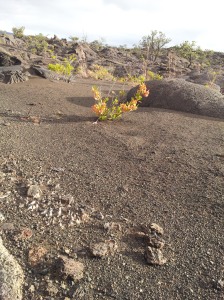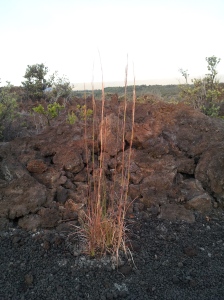
Hawaii – Ecopsychology and Peace
October 7, 2013Everywhere i went in Hawaii peace followed me. I don’t mean a feeling – i mean the sign. From arriving on World Peace Day, to my first discussion with a native Hawaiian (i hadn’t mentioned it, he brought it up to explain to me ‘why Hawaiians were so peaceful’), to a sign up at the Tibetan Buddhist temple where we held the ecopsychology conference proclaiming our need for peace. The place i most feel peace is in sand dunes, so here is a shot i took while sitting in the Ka U desert, to set the feeling:
All these coincidences really made me think. I don’t really believe world peace is possible. But have i become too realistic? My studies into utopian thinking revealed to me that without unbridled idealism, we may lose sight of the possibilities across the horizon, the positive attractors that draw us on in good work and hopeful actions. My own native intuition was always aligned to peaceful ways – but i had learnt too well that this could be because of my innate cowardice in the face of conflict – that what i thought were my own best intentions were actually a basic self-defensive manoeuvre. Perhaps this is still partly the case. But this doesn’t really answer why i recall this glow of loving kindness towards the universe and all beings before i even became aware of myself as a socialised being.
Desert grasses sprout as soon as volcanic ash is eroded down into black soil and moisture settles in.
Granted, we are being imprinted from day one, even as far back as in the womb, so that’s no conclusive argument against the cynical ways i have formerly accepted. Still, it’s a nice feeling and i know it as intrinsic to my self, so there’s no point agonising it out of existence. And, as Jorge Conesa-Sevilla reminded me at the conference, even if i believe i have no hope, i can still act with the right intentions. Cutting away delusion with the sword of wisdom! And loving kindness, which i sense is every bit as natural to the human soul as self-defense.
The speakers at the conference reminded me, beyond this personal fascination, of the ways we can reconnect with the world and help others to do the same. Tina Fields and Marcella Danon were outstanding, sharing their years’ worth of teaching that included basing a whole semester in a bus, living and learning mostly outdoors, and extending the practices of counselling and leadership training towards a planetary consciousness that is aware of our dependence on the earth and an expanded understanding of how our intelligence can enhance this creatively and responsively. Truly inspiring.
Lava flow hardened in ripples and flows, bubbling up from the earth and creating new land right beneath our feet.
Jorge’s work on resilience, which complements the too-easily co-opted term sustainability, was too short – i will be looking further into this and reporting on it here, as well as in my work in general. He also presented us with a basket woven from some speaker wire we found in the middle of the desert, as an example of teaching eco-semiotics; signs found in nature and with which we weave meanings, which store our relationships and other things we accumulate.
We experienced some ritualistic workshops with some very fine, well-grounded workers in the field. Cleo Apostolaki, from Greece, led us though an ode to Artemis in a ceremony of catharsis, which culminated in each participant releasing their unwanted items while wearing a laurel wreath she brought with her; while Teresita Dominguez, from Uruguay, led the circle through a smoking ceremony after which we wandered around the grounds until a symbol leapt into our attention from nature. As is so often the case, these quite simple rituals lead to some powerful realisations, and this was certainly the case for me.
There were also excellent talks about the way the ecological crisis can be formulated in light of the classic attachments (or afflictions, or ‘kleshas’) of Sanskrit lore – and how Patanjali’s Yoga Sutras can provide appropriate responses to this (Adrian Villasenor-Galarza); how the Polynesian practice of wayfinding, or navigating by the stars, can aid in ecological identity development (Melissa Edwards); how bioregionalism can cultivate leadership development (especially with troubled teen populations, Danielle Richardson); a recital of the kumulipo, or Hawaiian creation chant, with an introduction to the basic principles – which sound a lot like evolution, although with a very different way of grouping the beings involved (Kaikea Blackmore, who added that native Hawaiians are very comfortable with the fact that this creation continues on a daily basis on the Big Island!); and an artistic exploration into the relationship between the body and the earth – specifically, by way of naked photography in trees (Julianne Skai Arbor, aka Treegirl, see her blog here).
I know it’s not a great photo, but hey – it’s probably a pretty accurate representation of what i saw – volcanic plumes in the night, Volcano National Park at Mauna Loa, just before the US government saw fit to close it.
Finally, i spoke on my usual thing, light and ecospirituality, with more of a psychological perspective. What is it that we really want, i asked, that keeps us in this insane and ecocidal loop of consumerist materialism fired by the fossil fuel fetish? My provisional answers: love and beauty and power and embodied satisfaction – and a deeply moving relationship with the rest of nature, which we are sometimes hardly even aware of in modern, urban life. Can we have that without relying so much on cities filled with 24/7 artificial light? We’re going to have to learn how to, imho. Even if we did have enough oil and coal to keep the old dream alive, burning it will kill us and so much with it. And if we find an alternative energy source that doesn’t add to climate change and the greenhouse gas effect? Then, without an ecospiritual revolution, we won’t yet have been convinced that we have to stop consuming the earth – and we may become more dangerous than ever.
So is there a link between ecopsychology and peace? I’m still not sure. The way we think and act would be improved with more careful attention to the way we fit – or don’t – with the health of the overall biosystem, without a doubt. Being less aggressive about our so-called entitlements, our unrestrained desires, could surely help facilitate a world with less warfare. But in the end i am left with the gnawing hope, faint through enculturation but instinctive in body and soul, that peace is possible; and the knowledge that hope makes improvement more likely. This is the utopian inspiration across the horizon, which lies also beneath everyday ego attachments. And then i remember that great slogan: there is no way to peace, peace is the way.
Posted in Ecopsychology, Peace | Tagged Creativity, Critical Thinking, Culture, Ecological Awareness, Ecology, Ecopsychology, Materiality, Nature, Paganism, Peace, Ritual, Semiotics, Social Commentary, Symbolism |




Nice you got that shot of the plume. Should have brought my camera and tripod. Thanks for so kindly summarizing the week. I think I’ll write my next blog on the Rain, which has followed us to Maui. Off in search of rainbow gums and banyans in another closed National Park…
Good luck with the trees! Glad you’re getting some more time in Hawaii, even if it’s wet. I s’pose you’ll be skirting around some fences then …